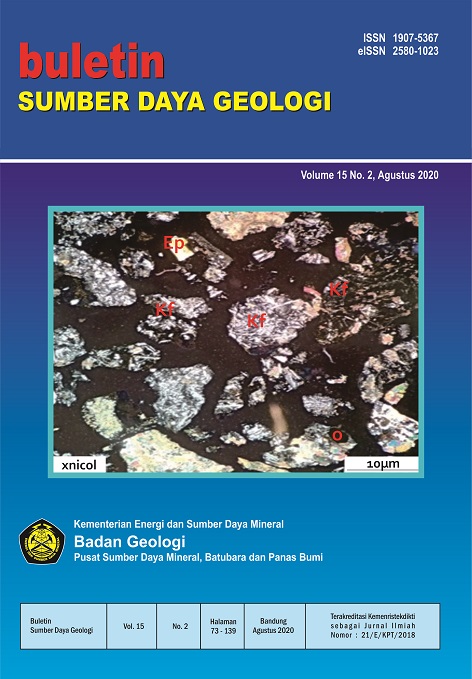KARAKTERISASI DAN ESTIMASI SUMBER DAYA GAMBUT SEBAGAI MATERIAL ADSORBEN LOGAM BERAT DALAM LARUTANDI BLOK TELUK MERANTI, KABUPATEN PELALAWAN, PROVINSI RIAU
CHARACTERIZATION AND RESOURCES ESTIMATION OF PEAT DEPOSIT AS HEAVY METAL ADSORBENT IN SOLUTIONAT TELUK MERANTI BLOCK, PELALAWAN REGENCY, RIAU PROVINCE
Abstract
Indonesia has the largest peat area in the tropical zone, which represents 70% of the peat area in Southeast Asia and 50% of the world's tropical peatlands. At present, the utilization of peat is still relatively low and its likelihood to cause major fires during dry season is still of great concern in Indonesia. On the other hand, peat has potential to be used as natural adsorbent. This study aims to characterize the adsorptive properties of peat and to estimate its possibleresources as natural heavy metal adsorbent in the Teluk Meranti Block. Peat characterization was carried out by selecting three peat samples, namely PL-13, PL-21 and PL-26 based on elemental analyses. The characterization of BET surface area showed that PL-13, PL-21, and PL-26 have maximum area of 241,73 m2/g, 241,80 m2/g dan 247,29 m2/g, respectively. The adsorption test results show that PL-13, PL-21, and PL-26 have maximum capacity of 15.06; 11.99; and 22.93 mg/g, with adsorption efficiencies of 46.79%; 48.36%; and 46.85%, respectively. Based on Government Regulation No. 57 of 2016, peat with a thickness of three meters or more is determined as protection function of the peat ecosystem. Accordingly, the inferred resources of peat deposits that can be utilized as adsorbent is estimated to be 90,477,890 tonnes.
Downloads
References
Aditya, K., Yusnimar.,&Zultiniar. (2016). Penentuan Model Isoterm Adsorpsi Ion Cu(II) Pada Karbon Aktif Tempurung Kelapa, 3(2), 1–6.
Agus, F., & Subiksa, I. G. M. (2008). Lahan Gambut : Potensi untuk pertanian dan aspek lingkungan. Balai Penelitian tanah dan World Agroforestry Centre (ICRAFT) Bogor. Indonesia.
Bailey, S. E., Olin, T. J., Bricka, R. M., & Adrian, D. D. (1999). A review of potentially low-cost sorbents for heavy metals. Water Research, 33(11), 2469-2479. https://doi.org/10.1016/S0043-1354 (98)00475-8
Bartczak, P., Norman, M., Klapiszewski, Ł., Karwańska, N., Kawalec, M., Baczyńska, M.,&Jesionowski, T. (2018). Removal of nickel(II) and lead(II) ions from aqueous solution using peat as a low-cost adsorbent: A kinetic and equilibrium study. Arabian Journal of Chemistry, 11(8), 1209-1222. https://doi.org/10.1016/j. arabjc.2015.07.018
Boron, D. J., Evans, E. W., & Peterson, J. M. (1987). An overview of peat research, utilization, and environmental considerations. International Journal of Coal Geology, 8(1-2), 1-31. https://doi.org/10.1016/0166-5162 (87)90020-6
Clarke, M.C.G., Kartawa, W., Djunuddin, A., Suganda, E., &Bagdja, M., 1982, Peta Geologi Lembar Pakanbaru, Sumatera. Bandung.
Dawodu, F. A.& Akpomie, K. G. (2014). Simultaneous adsorption of Ni(II) and Mn(II) ions from aqueous solution unto a Nigerian kaolinite clay. Journal of Materials Research and Technology, 3(2), 129-141. https:// doi.org/10.1016/j.jmrt.2014.03.002
Dewi, P. A. I. K., Sunarya, P.,& Sibarani, J. (2015). Adsorpsi Ion Logam Pb (II) dan Cu (II) Oleh Bentonit Teraktivasi Basa (NaOH). Jurnal Kimia, 9 (2), 235–242.
Goher, M. E., Hassan, A. M., Abdel-Moniem, I. A., Fahmy, A. H., Abdo, M. H., & El-sayed, S. M. (2015). Removal of aluminum, iron and manganese ions from industrial wastes using granular activated carbon and Amberlite IR-120H. Egyptian Journal of Aquatic Research, 41(2), 155-164. https://doi.org/10.1016/j.ejar.2015.04.002
Hikmatullah& Sukarman, (2014). Physical and Chemical PRoperties of Cultivated Peat Soils in Four TRial Sites of ICCTF in Kalimantan and Sumatra, Indonesia. Journal of Tropical Soils, 19(3), 131-141. DOI: 10.5400/jts.2014.19.3.131
Mirwan, A., & Wijayanti, H. (2011). Penurunan Ion Fe Dan Mn Air Tanah Kota Banjarbaru Menggunakan Tanah Lempung Gambut. Info Teknik, 12(1), 45-51.
Rezanezhad, F., Price, J. S., Quinton, W. L., Lennartz, B., Milojevic, T.,&Cappellen, P. V., (2016). Structure of peat soils and implications for water storage, flow and solute transport: A review update for geochemists. Chemical Geology, 429,75-84.
https://doi.org/10.1016/j.chemgeo.2016.03.010.
Skoog, D. A., Donald M, W., F, J. H., & Stanlesy R, C. (2000). Fundamentals of Analytical Chemistry. Brooks Cole.
Stevenson. (1994). Humus Chemistry, Genesis, Composition, Reactions.
Subarnas, A & Dwitama, E.P, 2019, Potensi Gambut Untuk Pengembangan PLTU, Di Kecamatan Teluk Meranti, Kabupaten Pelalawan, Provinsi Riau
Susandi Oksana dan Ahmad Taufiq A. (2017). Analisis Sifat Fisika Tanah Gambut Pada Hutan Gambut Di Kecamatan Tambang Kabupaten Kampar Provinsi Riau. Jurnal Agroteknologi, 5 No. 2(August), 23-28. https://doi.org/10.24014/ja.v5i2.1351
Tavlieva, M. P., Genieva, S. D., Georgieva, V. G., & Vlaev, L. T. (2015). Thermodynamics and kinetics of the removal of manganese(II) ions from aqueous solutions by white rice husk ash. Journal of Molecular Liquids, 211, 938-947.
https://doi.org/10.1016/j.molliq.2015.08.015
Tjahjono. (2007). Kajian Potensi Endapan Gambut Indonesia Berdasarkan Aspek Lingkungan. Departemen Energi Sumber Daya Mineral (ESDM).
Wahyunto, & Heryanto, B. (2005). Sebaran Gambut dan Status Terkini di Sumatera. In.CCFPI. Pemanfaatan Lahan Gambut Secara Bijaksana Untuk Manfaat Berkelanjutan. Wetlands International-Indonesia Program. Bogor.
Yuleli. (2009). Penggunaan Beberapa Jenis Fungi Untuk Meningkatkan Pertumbuhan Tanaman Karet (Hevea brasiliensis) di Tanah Gambut. Universitas Sumatera Utara. Medan.
Yuliani, G., Garnier, G., &Chaffee A.L. (2017). Utilization of raw and dried Victorian brown coal in the adsorption of model dyes from solution. Journal of Water Process Engineering, 15, 43-48.
Copyright (c) 2020 Buletin Sumber Daya Geologi

This work is licensed under a Creative Commons Attribution-NonCommercial-ShareAlike 4.0 International License.
Authors whose manuscripts are published agree to the following terms:
The publication rights of all journal manuscript materials published on the Buletin Sumber Daya Geologi website are held by the editorial board with the knowledge of the author (moral rights remain with the manuscript’s author).
The formal legal provisions for access to digital articles in this electronic journal are subject to the terms of the Creative Commons Attribution-ShareAlike (CC BY-SA) license. This means that Buletin Sumber Daya Geologi has the right to store, convert media/formats, manage in the form of a database, maintain, and publish the article without requesting permission from the author, as long as the author’s name is cited as the copyright holder.
Manuscripts published in both print and electronic formats are open access for educational, research, investigative, and library purposes. Beyond these purposes, the editorial board is not responsible for any violations of copyright law.















